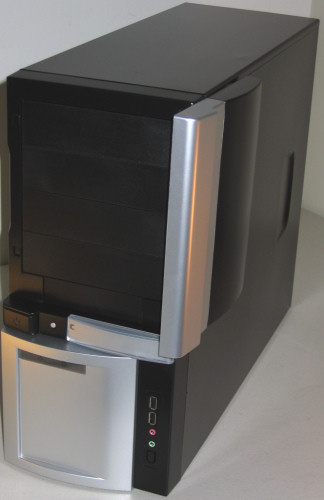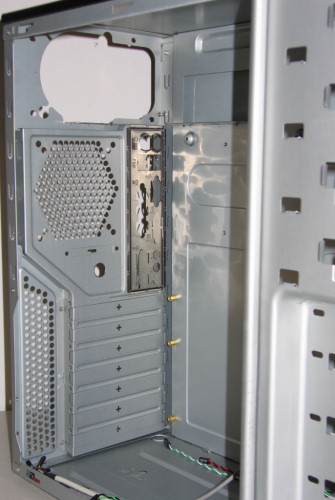Price-Point Comparing Three-Way Case Shootout
by Joshua Buss on January 13, 2006 12:05 AM EST- Posted in
- Cases/Cooling/PSUs
Dynapower E68 (cont’d)
The bezel doesn't just have the ability to slide at the bottom either; in addition to hinging to reveal the drive bays, the main portion (the top door) also slides along a couple of slits so that after opening, it can be further moved out of the way. While some people might consider such a dynamic front gaudy, it's still undeniable that it's a very nice front panel, especially given this unit's cost.
With all the attention that the front of this case has received, it's a good thing that the rest of the case is almost entirely devoid of anything that needs a lengthy explanation! This last picture of purely the exterior of the chassis really doesn't differ much from the other two cases that we've looked at all. Again, the side-mounted 120mm fan shows up, but besides that, there are no other elements of cooling to investigate here.
With that investigation over, let's dive into this value-oriented case. First off, as is probably to be expected, there are no tool-less elements in the E68. Also, we should mention that we actually routed the cables from the front through a different opening to help our cable management.
Even so, the actual expandability of the Dynapower case is just as good as the other two cases. Four hard drives, one external 3½“, and four external 5¼” drives can all be accommodated in the E68.
Support for different motherboard types is even more limited in this case, but again, the standard ATX types shouldn't be much of a problem, if at all.
Standard knock-out expansion card covers are the name of the game here, but unlike other incarnations, these won't sever an appendage when attempting to remove them. And considering the lack of tool-less options here, it's tough to beat the tried-and-true method of using a single screw to hold each add-in card in place.
Really, that's about all there is to the inside of the E68. With a steel construction, the case feels just as sturdy as the X1, and if one wants, they can add another 120mm fan in the back and 80mm in the front. Installing our test bed was entirely void of surprises. The side-mounted IDE cable was neither easier nor harder than in the previous mid-towers.
The bezel doesn't just have the ability to slide at the bottom either; in addition to hinging to reveal the drive bays, the main portion (the top door) also slides along a couple of slits so that after opening, it can be further moved out of the way. While some people might consider such a dynamic front gaudy, it's still undeniable that it's a very nice front panel, especially given this unit's cost.
With all the attention that the front of this case has received, it's a good thing that the rest of the case is almost entirely devoid of anything that needs a lengthy explanation! This last picture of purely the exterior of the chassis really doesn't differ much from the other two cases that we've looked at all. Again, the side-mounted 120mm fan shows up, but besides that, there are no other elements of cooling to investigate here.
With that investigation over, let's dive into this value-oriented case. First off, as is probably to be expected, there are no tool-less elements in the E68. Also, we should mention that we actually routed the cables from the front through a different opening to help our cable management.
Even so, the actual expandability of the Dynapower case is just as good as the other two cases. Four hard drives, one external 3½“, and four external 5¼” drives can all be accommodated in the E68.
Support for different motherboard types is even more limited in this case, but again, the standard ATX types shouldn't be much of a problem, if at all.
Standard knock-out expansion card covers are the name of the game here, but unlike other incarnations, these won't sever an appendage when attempting to remove them. And considering the lack of tool-less options here, it's tough to beat the tried-and-true method of using a single screw to hold each add-in card in place.
Really, that's about all there is to the inside of the E68. With a steel construction, the case feels just as sturdy as the X1, and if one wants, they can add another 120mm fan in the back and 80mm in the front. Installing our test bed was entirely void of surprises. The side-mounted IDE cable was neither easier nor harder than in the previous mid-towers.
















69 Comments
View All Comments
Tamale - Friday, January 13, 2006 - link
Thanks for the quick criticism guys. Article updated.Please continue to scrutinize :)
Viditor - Friday, January 13, 2006 - link
Another comment for your conclusion (which is important for those of us that do video work)...the P150 is the only one of the 3 that has Firewire connector in front (as far as I can tell). If you could list the specs of each case at the head of that cases segment, that would also help (e.g. number of 3.5 slots, front firewire connector, etc...).Cheers!
ceefka - Saturday, January 14, 2006 - link
The P150 also features a cable organizer. If you take of the right panel, you'll see it at the right side of the internal 3,5" drive bays. This can make your cabling a lot tidier than the picture in the review shows.The FireWire connection is S400 on an Intel standard. Those who wish to connect AMD boards might want to call Antec for an adapter cable.
All'n'all I think the P150 looks like a fridge. I bought it though because it made the most sense for its price.
Tamale - Saturday, January 14, 2006 - link
I've heard the P180 referred to as a fridge much moreso than the P150.. hehebut yah, good catch on the cable organizer.
andrewln - Friday, January 13, 2006 - link
i wonder if they suspended the hard drive or they used the brackets.... it makes a difference when the hard drive seeksyacoub - Friday, January 13, 2006 - link
For that matter I wonder if they had the 3-speed 120mm fan it comes with on the lowest setting for the sound tests or still ramped up to max from the cooling tests.gman003 - Friday, January 13, 2006 - link
Why only 3 cases in the roundup? Not much to compare to... :-(In any case, I would really love to see an Aspire case tested against these sometime. I've been building with them for a while now and IMO they look better and cool better than Antec or other so called "Gaming" cases.
Raidmax and Antec cases are nice, but Raidmax is too chinsy with their materials at times and Antec is sooooo overpriced sometimes that one really shouldn't even consider them anymore as their go to case because of so many other competing vendors out there with high quality cases at cheaper prices.
mindless1 - Friday, January 13, 2006 - link
True, Antec is often overpriced but (putting aside the possible issues with the power supply), it's expected that with the Antec one has a power supply they can use long-term. Raidmax power supplies I wouldn't even install in most systems. What would be most interesting is a P150 discounted due to no power supply until the issues with the present one are resolved.oofboi754 - Thursday, March 31, 2022 - link
This case isn't so bad. Put in some Noctua Fans in the front and back ant it keeps my 3060ti (EVGA XC) and 12700kf (NH-U12S) at a comfortable 40 Degrees Celcius when idling. The Noctua Fans combines with the quiet nature of this case keep my rig silent as possible. For it's age, the cable managment isn't bad, it just takes a bit of creative thinking. This case is great for a Sleeper PC like I made.